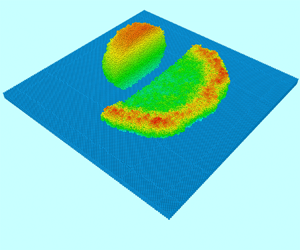Crossref Citations
This article has been cited by the following publications. This list is generated based on data provided by
Crossref.
Han, Ning-Ning
Wang, Shu-Wen
Sun, Bao-Min
and
He, Xin
2022.
Nanodroplet impacts on hydrophobic/superhydrophobic surfaces with point textures.
Journal of Applied Physics,
Vol. 132,
Issue. 20,
Han, Ning-Ning
Sun, Bao-Min
and
He, Xin
2022.
Split of droplets at the nanoscale using mixed-wettability surfaces: A molecular dynamics simulation.
Applied Surface Science,
Vol. 600,
Issue. ,
p.
154025.
Wang, Yi-Feng
Wang, Yi-Bo
He, Xin
Zhang, Ben-Xi
Yang, Yan-Ru
Wang, Xiao-Dong
and
Lee, Duu-Jong
2022.
Retraction dynamics of low-viscosity nanodroplets: From hydrophobic to hydrophilic surfaces.
Journal of Molecular Liquids,
Vol. 355,
Issue. ,
p.
118963.
Wang, Chen
Gilbert, Andrew D.
and
Mason, Joanne
2022.
An analytical study of the MHD clamshell instability on a sphere.
Journal of Fluid Mechanics,
Vol. 953,
Issue. ,
Han, Ningning
Huang, Boyu
Sun, Baomin
and
He, Xin
2022.
Oblique Impacts of Nanodroplets upon Surfaces.
Langmuir,
Vol. 38,
Issue. 43,
p.
13093.
Gao, Shu-Rong
Wei, Bo-Jian
Jin, Jia-Xin
Ye, Jin-Sheng
Wang, Yi-Feng
Zheng, Shao-Fei
Yang, Yan-Ru
and
Wang, Xiao-Dong
2022.
Contact time of a droplet impacting hydrophobic surfaces.
Physics of Fluids,
Vol. 34,
Issue. 6,
2023.
Scaling laws for the contact time of impacting nanodroplets: From hydrophobic to superhydrophobic surfaces.
Physics of Fluids,
Vol. 35,
Issue. 6,
Jin, Jia-Xin
Gao, Shu-Rong
Wei, Bo-Jian
Jia, Qi-Hui
Zheng, Shao-Fei
Yang, Yan-Ru
and
Wang, Xiao-Dong
2023.
Mechanism and contact time of off-center impacts at relatively high Weber numbers.
Physics of Fluids,
Vol. 35,
Issue. 2,
He, Xin
Cui, Kai
Dong, Wei Hai
Zhang, Xing Juan
Zhou, Ze Feng
and
Wang, Shuo Lin
2023.
Investigation of dynamic characteristics of impacting nanodroplets on solid surfaces decorated with a stepped texture.
Colloids and Surfaces A: Physicochemical and Engineering Aspects,
Vol. 670,
Issue. ,
p.
131581.
Ma, Qiang
Wang, Yi-Feng
Wang, Yi-Bo
Zhang, Ben-Xi
Zheng, Shao-Fei
Yang, Yan-Ru
Lee, Duu-Jong
and
Wang, Xiao-Dong
2023.
Pancake bouncing of nanodroplets impacting superhydrophobic surfaces.
Applied Surface Science,
Vol. 639,
Issue. ,
p.
158273.
Wang, Yi-Feng
Wang, Yi-Bo
Zhang, Cong-Lei
He, Xin
Yang, Yan-Ru
Zheng, Shao-Fei
Lee, Duu-Jong
and
Wang, Xiao-Dong
2023.
Retraction and bouncing dynamics of nanodroplets upon impact on superhydrophobic surfaces.
Physics of Fluids,
Vol. 35,
Issue. 3,
Ma, Yufei
and
Huang, Haibo
2023.
Scaling maximum spreading of droplet impacting on flexible substrates.
Journal of Fluid Mechanics,
Vol. 958,
Issue. ,
Wang, Yi-Feng
Ma, Qiang
Wei, Bo-Jian
Gao, Shu-Rong
Yang, Yan-Ru
Zheng, Shao-Fei
Lee, Duu-Jong
and
Wang, Xiao-Dong
2023.
Impact of nanodroplets on solid spheres.
Physics of Fluids,
Vol. 35,
Issue. 8,
Zhang, Aiping
Cui, Kai
Tian, Yuanyuan
Wang, Tieying
and
He, Xin
2023.
Dynamic characteristics of impacting binary nanodroplets on solid surfaces: From hydrophobic to superhydrophobic.
Journal of Molecular Liquids,
Vol. 389,
Issue. ,
p.
122873.
Wang, Yi-Bo
Wang, Yi-Feng
Ma, Qiang
Yang, Yan-Ru
Lee, Duu-Jong
and
Wang, Xiao-Dong
2023.
What Controls the Hole Formation of Nanodroplets: Hydrodynamic or Thermodynamic Instability?.
Langmuir,
Vol. 39,
Issue. 33,
p.
11760.
2023.
Reducing the contact time of off-center impacts.
Physics of Fluids,
Vol. 35,
Issue. 4,
Liu, Hailong
Zheng, Nuo
Chen, Jiaqi
Yang, Ding
and
Wang, Junfeng
2023.
Study on the Bouncing Behaviors of a Non-Newtonian Fluid Droplet Impacting on a Hydrophobic Surface.
Langmuir,
Vol. 39,
Issue. 11,
p.
3979.
Gao, Shu-Rong
Jin, Jia-Xin
Shi, Shi-Hua
Wei, Bo-Jian
Wang, Yi-Feng
Zheng, Shao-Fei
Yang, Yan-Ru
and
Wang, Xiao-Dong
2023.
Critical contact angle of a bouncing droplet.
Physics of Fluids,
Vol. 35,
Issue. 7,
2023.
Contact time of nanodroplets obliquely impacting nanopillar-arrayed superhydrophobic surfaces: A molecular dynamics study.
Physics of Fluids,
Vol. 35,
Issue. 6,
Liu, Hanyi
Zhang, Jun
Luo, Jia
and
Wen, Dongsheng
2023.
Impact of nanodroplets on cone-textured surfaces.
Physical Review E,
Vol. 107,
Issue. 6,

 ${\beta _{max}}\sim W{e^{1/5}}$ in the low-Weber-number range (capillary regime) and
${\beta _{max}}\sim W{e^{1/5}}$ in the low-Weber-number range (capillary regime) and  ${\beta _{max}}\sim W{e^{2/3}}R{e^{ - 1/3}}$ (or
${\beta _{max}}\sim W{e^{2/3}}R{e^{ - 1/3}}$ (or  ${\beta _{max}}\sim W{e^{1/2}}O{h^{1/3}}$) in the high-Weber-number range (cross-over regime) are obtained. Here, We, Re, and Oh are the Weber number, Reynolds number, and Ohnesorge number, respectively. Although the scaling laws are proposed only for the ideal superhydrophobic surface, they are tested valid for θ over 73° owing to the ignorable zero-velocity spreading effect. Furthermore, combining the two scaling laws leads to an impact number,
${\beta _{max}}\sim W{e^{1/2}}O{h^{1/3}}$) in the high-Weber-number range (cross-over regime) are obtained. Here, We, Re, and Oh are the Weber number, Reynolds number, and Ohnesorge number, respectively. Although the scaling laws are proposed only for the ideal superhydrophobic surface, they are tested valid for θ over 73° owing to the ignorable zero-velocity spreading effect. Furthermore, combining the two scaling laws leads to an impact number,  $W{e^{3/10}}O{h^{1/3}} = 2.1$. This impact number can be used to determine whether viscous force is ignorable for impacting nanodroplets, thereby distinguishing the capillary regime from the cross-over regime.
$W{e^{3/10}}O{h^{1/3}} = 2.1$. This impact number can be used to determine whether viscous force is ignorable for impacting nanodroplets, thereby distinguishing the capillary regime from the cross-over regime.


